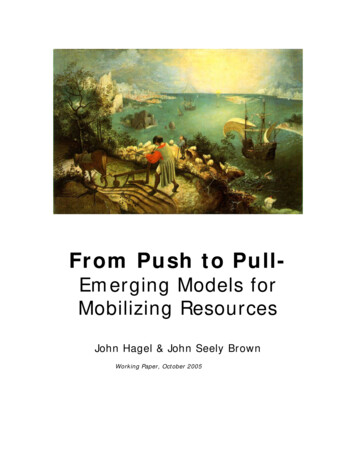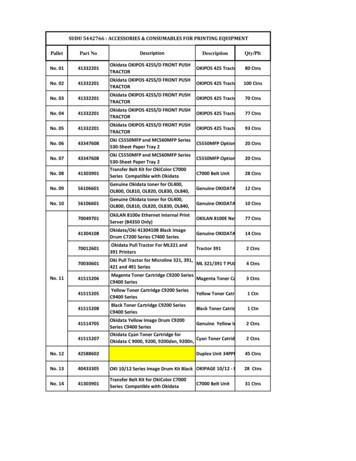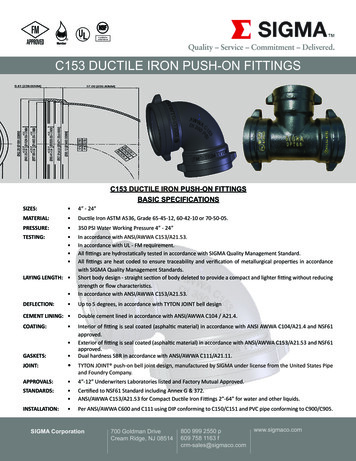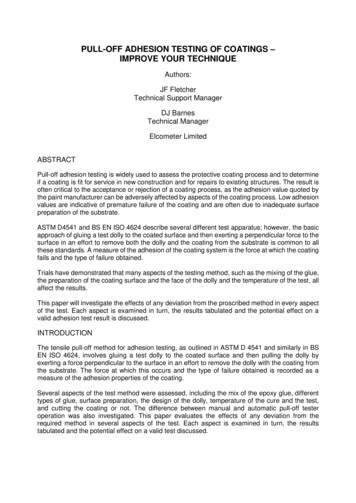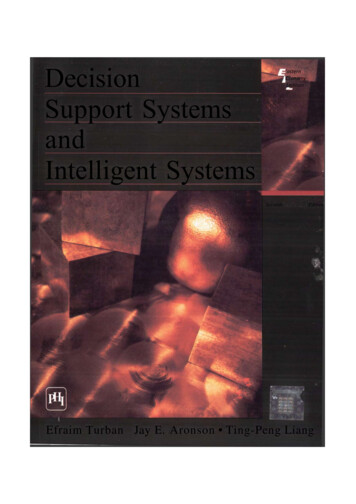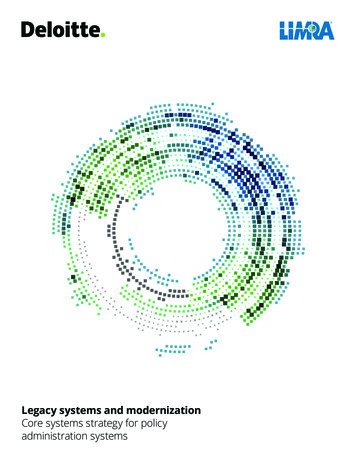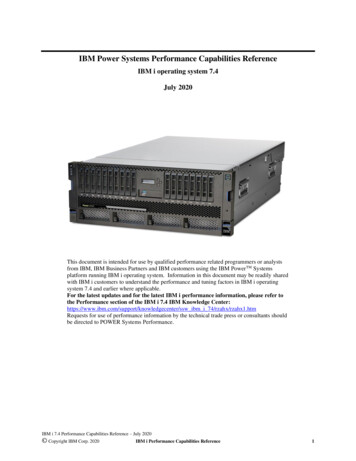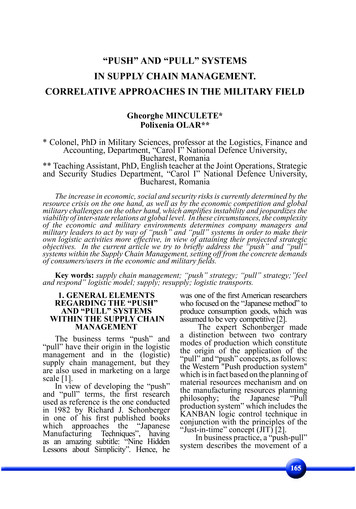
Transcription
“PUSH” AND “PULL” SYSTEMSIN SUPPLY CHAIN MANAGEMENT.CORRELATIVE APPROACHES IN THE MILITARY FIELDGheorghe MINCULETE*Polixenia OLAR*** Colonel, PhD in Military Sciences, professor at the Logistics, Finance andAccounting, Department, “Carol I” National Defence University,Bucharest, Romania** Teaching Assistant, PhD, English teacher at the Joint Operations, Strategicand Security Studies Department, “Carol I” National Defence University,Bucharest, RomaniaThe increase in economic, social and security risks is currently determined by theresource crisis on the one hand, as well as by the economic competition and globalmilitary challenges on the other hand, which amplifies instability and jeopardizes theviability of inter-state relations at global level. In these circumstances, the complexityof the economic and military environments determines company managers andmilitary leaders to act by way of “push” and “pull” systems in order to make theirown logistic activities more effective, in view of attaining their projected strategicobjectives. In the current article we try to briefly address the “push” and “pull”systems within the Supply Chain Management, setting off from the concrete demandsof consumers/users in the economic and military fields.Key words: supply chain management; “push” strategy; “pull” strategy;”feeland respond” logistic model; supply; resupply; logistic transports.1. GENERAL ELEMENTSREGARDING THE “PUSH”AND “PULL” SYSTEMSWITHIN THE SUPPLY CHAINMANAGEMENTThe business terms “push” and“pull” have their origin in the logisticmanagement and in the (logistic)supply chain management, but theyare also used in marketing on a largescale [1].In view of developing the “push”and “pull” terms, the first researchused as reference is the one conductedin 1982 by Richard J. Schonbergerin one of his first published bookswhich approaches the “JapaneseManufacturing Techniques”, havingas an amazing subtitle: “Nine HiddenLessons about Simplicity”. Hence, hewas one of the first American researcherswho focused on the “Japanese method” toproduce consumption goods, which wasassumed to be very competitive [2].The expert Schonberger madea distinction between two contrarymodes of production which constitutethe origin of the application of the“pull” and “push” concepts, as follows:the Western "Push production system"which is in fact based on the planning ofmaterial resources mechanism and onthe manufacturing resources planningphilosophy; the Japanese “Pullproduction system” which includes theKANBAN logic control technique inconjunction with the principles of the“Just-in-time” concept (JIT) [2].In business practice, a “push-pull”system describes the movement of a
product or related piece of informationbetween two subjects. Thus, on themarket the consumers usually “pull”the goods and pieces of informationadequate to their demand in order tosatisfy their needs, while offerers andsuppliers “push” the required products/services toward consumers/customers.In the logistic and supply chains, bothpush and pull modes usually functions,in order to supply toward customers thedemanded products and services [2].In the field of marketing, a “push”strategy is used when the developmentand improvement of a new product,unknown to consumers/users, existed.In the situation where no consumptiondemand for the product to be launchedwas noticed, the product and the relatedinformation are “pushed” toward theconsumer through distribution andpromotion. Due to the asymmetry ofinformation, producers permanently actin support of consumers/customers inorder to reduce the pack of informationwith regard to the products and servicesbeing offered [3].The Supply Chain Managementbased on the “push” mode ischaracterized by the fact that productsare “pushed” through distributionchannels from production to retailers.The producer establishes the level ofproduction in accordance with thequantities recorded in the historicalorders issued by retailers. It thusresults that a longer period of timeis required for a supply chain basedon the “push” system to meet thechanges in demand, which may leadto increased stocks or blockages anddelays (due to unacceptable servicesand obsolescence of products) [4].In the practice of relationalmarketing, the consumer demandsthe product suitable to the “pull”systems and he “pulls” it through thedistribution channel. For example, alarge vehicle manufacturing companyproduces the make or makes launchedon the market when they were orderedby customers. Thus, in these conditionsthe application of the “pull” systemwithin the supply chain is explained by:increased uncertainty of demand on themarket; production and distribution areled by demand; lack of stocks due tothe adequate response to specific orders;decrease of the time to run the businessetc [4].In a Supply Chain Managementbased on the “pull” mode, purchasing,production and distribution are led bydemand, so that they are coordinatedby the actual orders of the customers(compared to the anticipated demandmentioned earlier).On the basis of the aspectsemphasized in the case of the “pull”system, if we have in mind the suppliersnecessary to a company whose productsare demanded by customers on variousmarkets, we must keep in mind thespecific relations within the supplychain pertaining to the procurement ofthe materials required by the productionprocess. Thus, within this functionalmechanism, the suppliers in the supplychain get involved in managing thestocks of the producing company, withwhich they have normal legal andbusiness relations, by using the stockmanaged by the supplier system [5].To this end, the producing companytransmits to its suppliers informationwith regard to the actual demand, thesituation of its stocks, other logisticelements etc. The obtained informationallows suppliers to intervene at theopportune moment to complete thestocks (by sending advices of delivery).Following this procedure, the expectedpositive economic effects emergewithin the producing company, makingreference to the reduction of: theduration of the projected productioncycle, the number of employedpersonnel, the level of total costs. Atthe same time, the precision withinthe logistic chains increase through
the concretization of the economicfluxes: inputs - conversion - outputs distribution - complete satisfaction ofconsumer/user requirements [5].In Figure 1 a simple mechanismacting within a Supply ChainManagement for the functioning ofthe “push” and “pull” systems can beobserved.Fig. no. 1. Emphasis of the “push” and “pull”systems in Supply Chain Management [6]A Supply Chain Management isalmost always a combination of the two“push” and “pull” procedures, case inwhich the interface between the two isknown under the border name of “pushpull”. In this framework, the levels ofinventory of the individual componentsare determined by the forecasted generaldemand, but the final assemblingrepresents the response to the specificdemand by customers. Thus, the “pushpull” border would then be at thebeginning of the assembling line [3].The mechanism of distribution ofgoods is nowadays in a continuouschange of paradigm between the“production for supply” (it implieslogistics based on stocks and “push”logistics)toward“productionupon demand” (it determines thelogistics based on resupply and“pull” logistics). Thus, the elementsof the paradigm range betweenmaintaining the stocks necessary forthe approximate satisfaction of thedemand through a complete systemof assurance, especially throughproduction and transport on demand,in order to precisely respond tocustomer requirements [6].2. “PUSH” AND “PULL” SUPPLY/RESUPPLY SYSTEMS IN THEMILITARY DISTRIBUTIONMECHANISMDuring the last two decades asignificant transformation in logisticshas been observed in the UnitedStates Armed Forces, following theimprovement of the mobility in the landair-sea triad, transport infrastructure andIn-Transit-Visibility (ITV). Accordingto American specialists, a furtherincrease in capability is still necessary,having in mind the principles of JointVision 2020 which emphasizes theimportance of the dominant manoeuvrethrough the speed and agility of theforces designated to the complexmilitary operations of the future. In thissense, Operation Iraqi Freedom (OIF)demonstrated some of the capacities ofthe network base warfare of the XXIcentury, as well as a number of currentand future logistic challenges [7].The Sense and Respond (S & R)logistics represents a solution inaccordance with the concepts of thewar of the future, because it usesfirm commercial practices and ecoservice military supply concepts, aswell as information, operations andlogistics related technology adequateto a network work mode [8]. Thus,the network facilitates the connectionbetween transport and supply. Thiswill determine the general reductionof the logistic foothold in the theatreof operations, taking into accountthe lessons learned regarding thevulnerability of long resupply linesexperimented during OIF [7].It is worth mentioning that innowadays industry both the “push” andthe “pull” systems exist. Apparently,smaller stocks tend to favour a “pull”system. Military specialists argue thatthe accumulation of large stocks indistribution points in the theatre of
operations reduces the effectivenessand manoeuvrability of the combatantforces. Such stocks also have anegative impact on ITV/TAV (TotalAsset Visibility) because of the largework volume of the support units.In contrast, a “Just-in-Time” supplyapproach in industry, which inclinesmore toward a “pull system”, presentsa greater risk to the fighters [9]. Thisrisk is determined by potential loss oflives during combat and commanders'ability to counter enemy actions. Acommander cannot afford even thesmallest chances of materials andsupplies being delivered late. In thetheatre of operations large stocks arenot to be desired, and neither minimumstocks in support of military operations.A more balanced approach is rathermore favourable, somewhere betweenhuge and minimum stocks (the industrialmodel), which allows for a small safetymargin for military operations whichpermanently require a flexible and leanlogistic support. As in the situation ofthe commercial supply chain, whereits specific operations are permanentlymonitored, military leaders andlogisticians must know at any given timethe movement in the distribution systemof the materials (on classes) destined toresupply [7; 10].According to the belief ofAmerican experts, the efforts of theDepartment of Defence to transformlogistics must continue in the directionof a progress toward a “push” systemfor all types of supply. To this end,the development of the “push” systemrepresents the systemic approach to amajor change in logistics, due to theuse of the best commercial practices inthe field of Supply Chain Management.At the same time, the “push” systemcorrelates with the “Sense and Respond”(S & R) logistic model, which is alsoa “push” system developed by IBM.Hence, the integrated approach of the“push” system represents the type oflogistic transformation occurring in theAmerican Armed Forces in support ofthe network centric warfare [7; 10].This way, a “push” system will bemore effective also through the growingoperational capacity of the force byway of quicker and more crediblesupport provided to combating forces.This effectiveness is possible becauseinformation, operations and logistics arecorrelated in a complex manner in an ITV/TAV network, which allows logisticiansto “pull” the scheduled materials andsupplies to the units, initially on thebasis of planning factors, and then inreal time, due to knowledge regardingthe progress of the actions specific tothe battle field [7; 10].Some support materials (forexample rations, ammunition, fuels,lubricants) are better dealt with ina “push” system in case they areprocessed and delivered on the basis ofa weekly or monthly schedule, havingin mind the logistic planning factorsdetermined by the size of the force, itsmission and the estimated consumption.The advantage of the “push” system isthat it is not based on demand, whichdetermines the rapid unfolding of theprocess (in the supply chain) from theinitial input point, continuing withdistribution (sail, delivery), up to theend consumer (combatant) [7; 10].At the same time, Americanlogisticians assert that the “push” systemwill eventually be capable of givingan impulse to many other capabilities,including by fully putting into practiceof the RFID. It thus results that, oncea “push” system is developed to meetthe requirements of a modern army, thecombatant will have more confidencethat necessary transport will reach himin time and thus numerous requirementsfor the same resupply item will cease.Operational commanders will alsobenefit from an optimization of thetransported goods, which will shortenthe time allotted for delivery [7].
At the same time, nowadays thelogistic support with individual servicesis oriented toward a “pull” systemlargely dependent on automated andend-to-end rapid distribution systems.Nevertheless, the “pull” systemis generally used for the materialsdestined to resupply which havevarious rates of use/consumption.Many critical materials destinedto resupply (for example spare parts),which have different rates of use/consumption, are ordered through a“pull” system, which uses demandshierarchicallylaunchedtowardthe sources. The process specificto demand is dependent on directcommunication between the logisticpersonnel and the large / operationalunits [10]. Under these conditions, thedelivery deadline set by the requiringunit is often delayed due to a moreprolonged processing time betweenorder and supply. Due to the lack ofsynchronicity between the transportand supply functions and the lack ofvisibility of demands and transfers inthe system, especially in the theatre,various items destined to resupply arerepeatedly ordered, thus determiningthe emergence of dysfunctions in thelogistic chain (deliveries of exceeding
IN SUPPLY CHAIN MANAGEMENT. CORRELATIVE APPROACHES IN THE MILITARY FIELD Gheorghe MINCULETE* Polixenia OLAR** * Colonel, PhD in Military Sciences, professor at the Logistics, Finance and Accounting, Department, “Carol I” National Defence University, Bucharest, Romania ** Teaching Assistant, PhD, English teacher at the Joint Operations, Strategic and Security Studies
